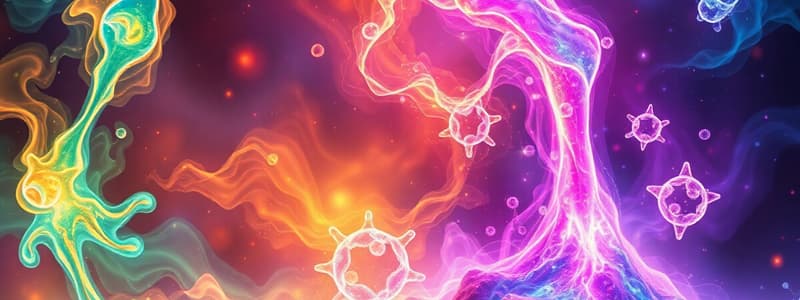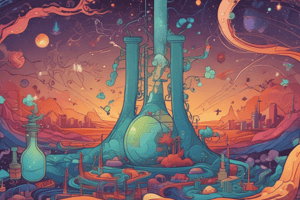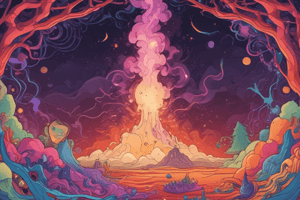Podcast
Questions and Answers
Which term describes a new solid formed when clear solutions are mixed?
Which term describes a new solid formed when clear solutions are mixed?
- Saturated Solution
- Effervescence
- Precipitate (correct)
- Solution
What is a characteristic of an endothermic reaction?
What is a characteristic of an endothermic reaction?
- Light is produced during the reaction
- Energy is released into the environment
- Temperature decreases as the reaction proceeds
- Heat is absorbed from the surroundings (correct)
What process is used to separate a soluble solid from a solution?
What process is used to separate a soluble solid from a solution?
- Evaporation (correct)
- Chromatography
- Distillation
- Filtration
Which factor has the least effect on the rate of reaction?
Which factor has the least effect on the rate of reaction?
Which of the following best defines solubility?
Which of the following best defines solubility?
What is the primary function of a catalyst in a chemical reaction?
What is the primary function of a catalyst in a chemical reaction?
How does decreasing the particle size of a reactant affect the reaction rate?
How does decreasing the particle size of a reactant affect the reaction rate?
What does effervescence indicate in a chemical reaction?
What does effervescence indicate in a chemical reaction?
Which of the following groups contains gases at room temperature?
Which of the following groups contains gases at room temperature?
What is the correct chemical formula for carbon dioxide?
What is the correct chemical formula for carbon dioxide?
What does the prefix 'Tetra-' signify in chemical names?
What does the prefix 'Tetra-' signify in chemical names?
What is the valency of Oxygen based on the provided group number?
What is the valency of Oxygen based on the provided group number?
Which ion has a valency of 3?
Which ion has a valency of 3?
What valency is commonly associated with transition metals?
What valency is commonly associated with transition metals?
What charge do nonmetals acquire by gaining electrons?
What charge do nonmetals acquire by gaining electrons?
Which of the following is an indicator of a chemical reaction?
Which of the following is an indicator of a chemical reaction?
In chemical formulas with prefixes, what happens if one element is prefixed and the other is not?
In chemical formulas with prefixes, what happens if one element is prefixed and the other is not?
Which of the following is a characteristic of group 0 elements?
Which of the following is a characteristic of group 0 elements?
What type of bond involves the sharing of 6 electrons?
What type of bond involves the sharing of 6 electrons?
In terms of electron arrangement, how do metals achieve stability?
In terms of electron arrangement, how do metals achieve stability?
Which arrangement corresponds to a trigonal pyramidal shape?
Which arrangement corresponds to a trigonal pyramidal shape?
What is produced during an endothermic reaction?
What is produced during an endothermic reaction?
Which of the following statements describes a physical change?
Which of the following statements describes a physical change?
What term describes a solution that cannot dissolve any more solute at a specific temperature?
What term describes a solution that cannot dissolve any more solute at a specific temperature?
What state symbol represents a gas in a chemical equation?
What state symbol represents a gas in a chemical equation?
Which method is used to balance a chemical equation if necessary?
Which method is used to balance a chemical equation if necessary?
What type of bond is formed when two non-metals share electrons?
What type of bond is formed when two non-metals share electrons?
Which of the following is true about ionic compounds?
Which of the following is true about ionic compounds?
How can atoms achieve a stable electron configuration?
How can atoms achieve a stable electron configuration?
What characteristic defines a double bond between two atoms?
What characteristic defines a double bond between two atoms?
In the reaction H₂ + O₂ → H₂O, which element is being combined in this balanced equation?
In the reaction H₂ + O₂ → H₂O, which element is being combined in this balanced equation?
What happens to non-metals when they gain electrons?
What happens to non-metals when they gain electrons?
What does the atomic number represent?
What does the atomic number represent?
Which statement is true regarding isotopes?
Which statement is true regarding isotopes?
What is the mass number of an atom?
What is the mass number of an atom?
How is a negative ion formed?
How is a negative ion formed?
What does the relative atomic mass (RAM) represent?
What does the relative atomic mass (RAM) represent?
What is the maximum number of electrons in the first energy shell?
What is the maximum number of electrons in the first energy shell?
In the periodic table, how are elements organized?
In the periodic table, how are elements organized?
What is indicated by a target diagram?
What is indicated by a target diagram?
Which group contains very reactive metals that react with water to produce hydrogen?
Which group contains very reactive metals that react with water to produce hydrogen?
What is the primary characteristic of transition metals?
What is the primary characteristic of transition metals?
Which of the following elements is classified as a gaseous element at room temperature?
Which of the following elements is classified as a gaseous element at room temperature?
How is the chemical formula for carbon dioxide represented?
How is the chemical formula for carbon dioxide represented?
What does the prefix 'Di-' represent in chemical nomenclature?
What does the prefix 'Di-' represent in chemical nomenclature?
What is the valency of an element in Group 7?
What is the valency of an element in Group 7?
Which of the following is a characteristic of noble gases?
Which of the following is a characteristic of noble gases?
What does the Roman numeral in Iron(III) chloride indicate?
What does the Roman numeral in Iron(III) chloride indicate?
Flashcards
Covalent Bond
Covalent Bond
A type of chemical bond where atoms share electrons to achieve a stable electron configuration. The number of shared electrons determines the type of bond: single bond (2 electrons), double bond (4 electrons), or triple bond (6 electrons).
Exothermic Reaction
Exothermic Reaction
A chemical reaction where heat energy is released into the surroundings. These reactions often feel hot to the touch.
Endothermic Reaction
Endothermic Reaction
A chemical reaction that absorbs heat energy from the surroundings. These reactions often feel cold to the touch.
Solute
Solute
Signup and view all the flashcards
Solvent
Solvent
Signup and view all the flashcards
Saturated Solution
Saturated Solution
Signup and view all the flashcards
Precipitate
Precipitate
Signup and view all the flashcards
Effervescence
Effervescence
Signup and view all the flashcards
What is a chemical formula?
What is a chemical formula?
Signup and view all the flashcards
What do prefixes in chemical formulas indicate?
What do prefixes in chemical formulas indicate?
Signup and view all the flashcards
What is valency?
What is valency?
Signup and view all the flashcards
How is valency shown for transition metals?
How is valency shown for transition metals?
Signup and view all the flashcards
What are group ions?
What are group ions?
Signup and view all the flashcards
What is the swap and drop method?
What is the swap and drop method?
Signup and view all the flashcards
What are noble gases?
What are noble gases?
Signup and view all the flashcards
What are the states of matter for elements at room temperature?
What are the states of matter for elements at room temperature?
Signup and view all the flashcards
State Symbols
State Symbols
Signup and view all the flashcards
Balancing Chemical Equations
Balancing Chemical Equations
Signup and view all the flashcards
Covalent Bonding
Covalent Bonding
Signup and view all the flashcards
Ionic Bonding
Ionic Bonding
Signup and view all the flashcards
Electron Configuration
Electron Configuration
Signup and view all the flashcards
Covalent Bond Strength
Covalent Bond Strength
Signup and view all the flashcards
Double Bond
Double Bond
Signup and view all the flashcards
Triple Bond
Triple Bond
Signup and view all the flashcards
Rate of Reaction
Rate of Reaction
Signup and view all the flashcards
Catalyst
Catalyst
Signup and view all the flashcards
Atomic Number
Atomic Number
Signup and view all the flashcards
Mass Number
Mass Number
Signup and view all the flashcards
Isotopes
Isotopes
Signup and view all the flashcards
Relative Atomic Mass (RAM)
Relative Atomic Mass (RAM)
Signup and view all the flashcards
Ion
Ion
Signup and view all the flashcards
Electron Arrangement
Electron Arrangement
Signup and view all the flashcards
Outer Electron Diagram
Outer Electron Diagram
Signup and view all the flashcards
Periodic Table
Periodic Table
Signup and view all the flashcards
What is a Compound?
What is a Compound?
Signup and view all the flashcards
What are the properties of Metals and Non-metals?
What are the properties of Metals and Non-metals?
Signup and view all the flashcards
What are Alkali Metals?
What are Alkali Metals?
Signup and view all the flashcards
What are Transition Metals?
What are Transition Metals?
Signup and view all the flashcards
What are Halogens?
What are Halogens?
Signup and view all the flashcards
What does a Chemical Formula represent?
What does a Chemical Formula represent?
Signup and view all the flashcards
Study Notes
Chemical Reactions
- New substances are always produced in chemical reactions
- These reactions are usually difficult to reverse
- Physical changes involve changes in state and are easily reversed
- No new substances are formed in physical changes
Chemical Changes Examples
- Car rusting
- Boiled egg (formation of solid)
- Burning toast
Physical Changes Examples
- Ice cream melting
- Draining water from rice
- Stirring sugar into a cup of tea
Indicators of Chemical Reactions
- Color change
- Gas production
- Formation of a new solid
- Energy change (heat, light, or sound)
Energy Changes
- Temperature increases during exothermic reactions (heat given off)
- Temperature decreases during endothermic reactions (heat absorbed)
- Light or sound production can also occur
Effervescence
- Gas bubbles forming in a liquid
Precipitate
- Formation of a new solid when clear solutions mix
Solutions
- Solute: Substance being dissolved
- Solvent: Liquid doing the dissolving (e.g., water, alcohol)
- Solution: Liquid with something dissolved in it
- Saturated Solution: Cannot dissolve more solute at a given temperature
- Soluble: Substances that dissolve well
- Insoluble: Substances that do not dissolve well
Separating Mixtures
- Filtration: Separating an insoluble solid from a liquid
- Evaporation: Separating dissolved solutes from a liquid
- Distillation: Separating liquids with different boiling points
Word Equations
- Chemicals that react together are reactants
- Chemicals produced are products
Rates of Reaction
- Particle Size: Smaller particles react faster due to increased surface area
- Temperature: Higher temperatures increase reaction rates
- Concentration: Higher concentrations increase reaction rates
- Catalyst: Speeds up reactions without being consumed
Measuring Reaction Rates
- Measure volume of gas: Using inverted measuring cylinders or gas syringes
- Measure mass change: Using a balance
Atomic Structure
- Atoms are stable and neutral due to an equal number of protons and electrons
- Mass Number: Number of protons plus neutrons.
- Atomic Number: Number of protons
- Number of Neutrons: Mass number minus atomic number
Isotopes
- Atoms having the same number of protons but a different number of neutrons
- Have the same atomic number but different mass numbers
Relative Atomic Mass
- Average atomic mass taking the abundance of each isotope in account
Ions
- Unbalanced atoms that have either gained or lost electrons
- Negative ions gain electrons
- Positive ions lose electrons
Electron Arrangement
- Electrons fill electron energy levels (shells) starting from the innermost shell
- Maximum 2 electrons in the first shell, 8 in the second and third
Target Diagram Rules
- Shells are filled starting from the innermost (first) to outermost (next)
- The first shell has a maximum of 2 electrons. The next ones progressively have a maximum of 8
Covalent Compounds
- Formed when non-metals share electrons to complete their outer electron shells
- Outer electron diagrams are similar to target diagrams, but only show the outer (last) electron shell
Studying That Suits You
Use AI to generate personalized quizzes and flashcards to suit your learning preferences.




